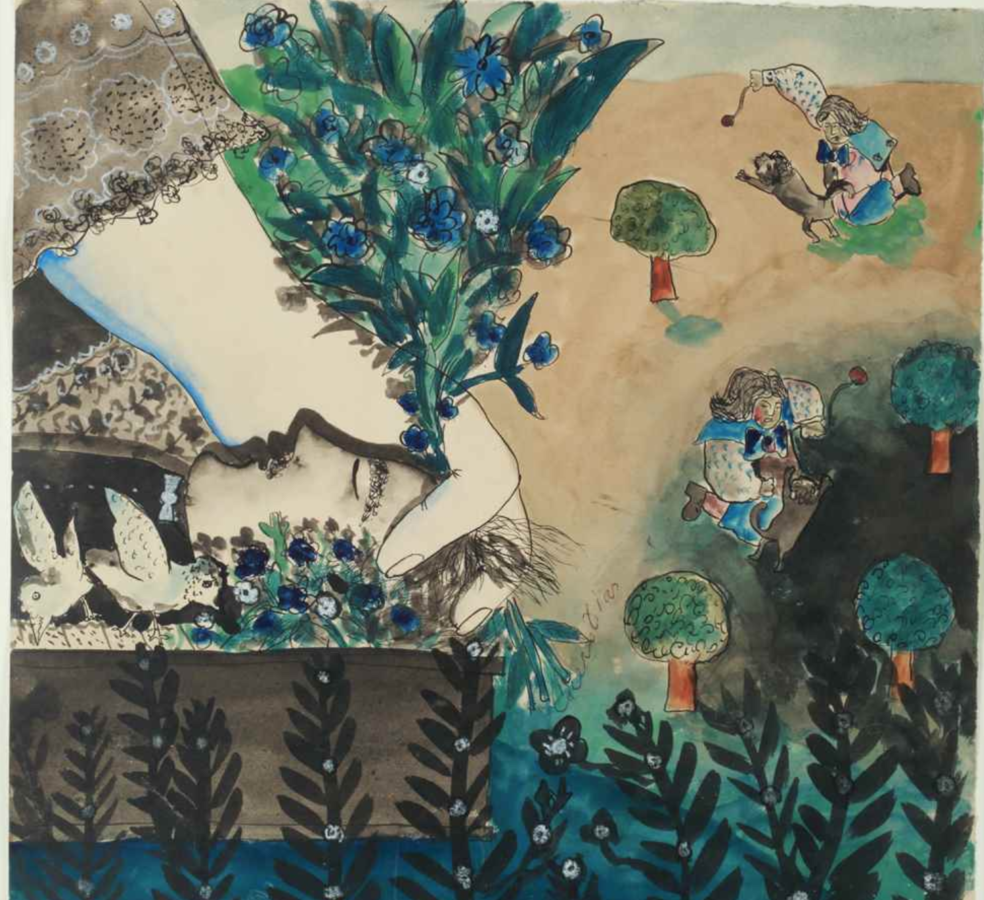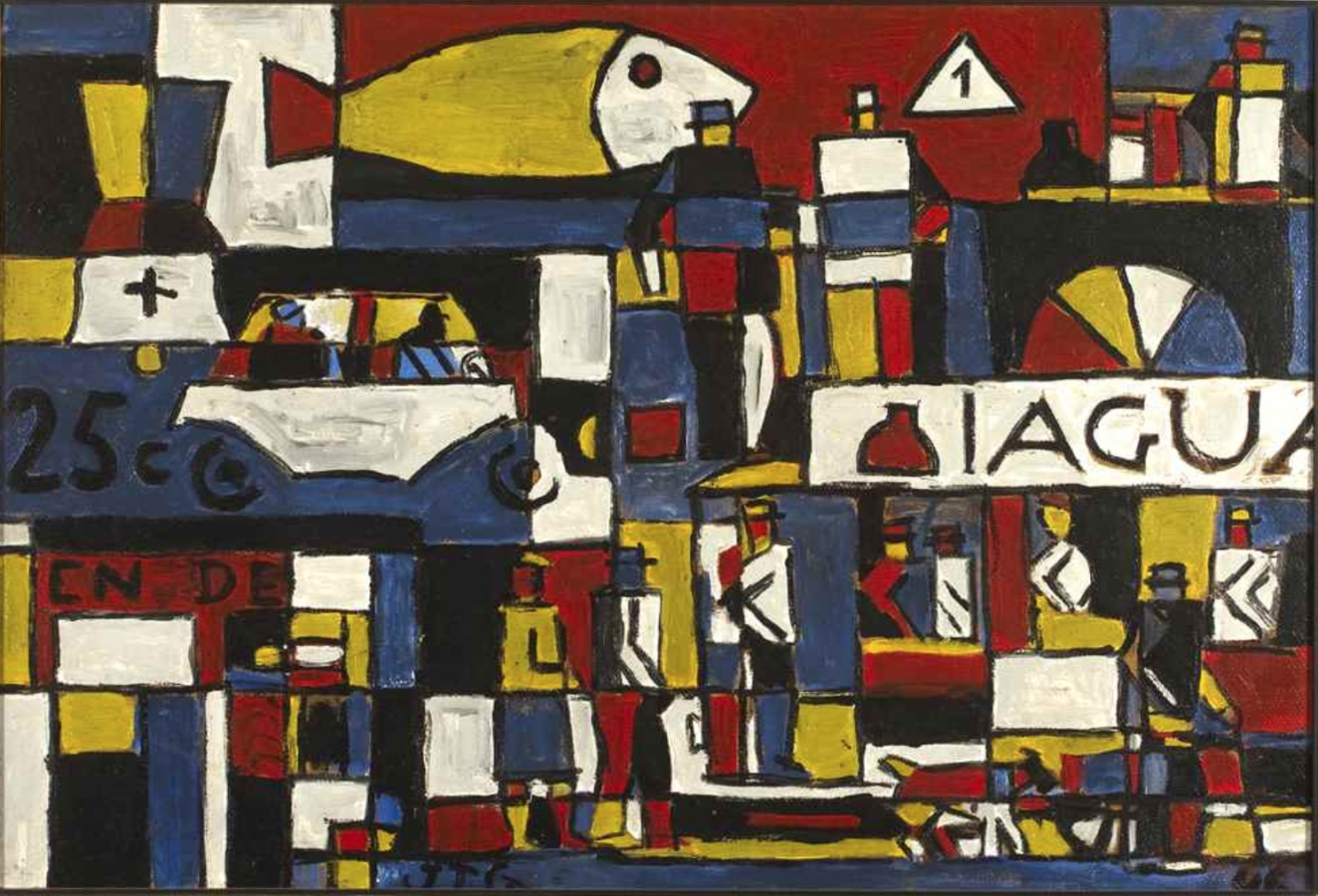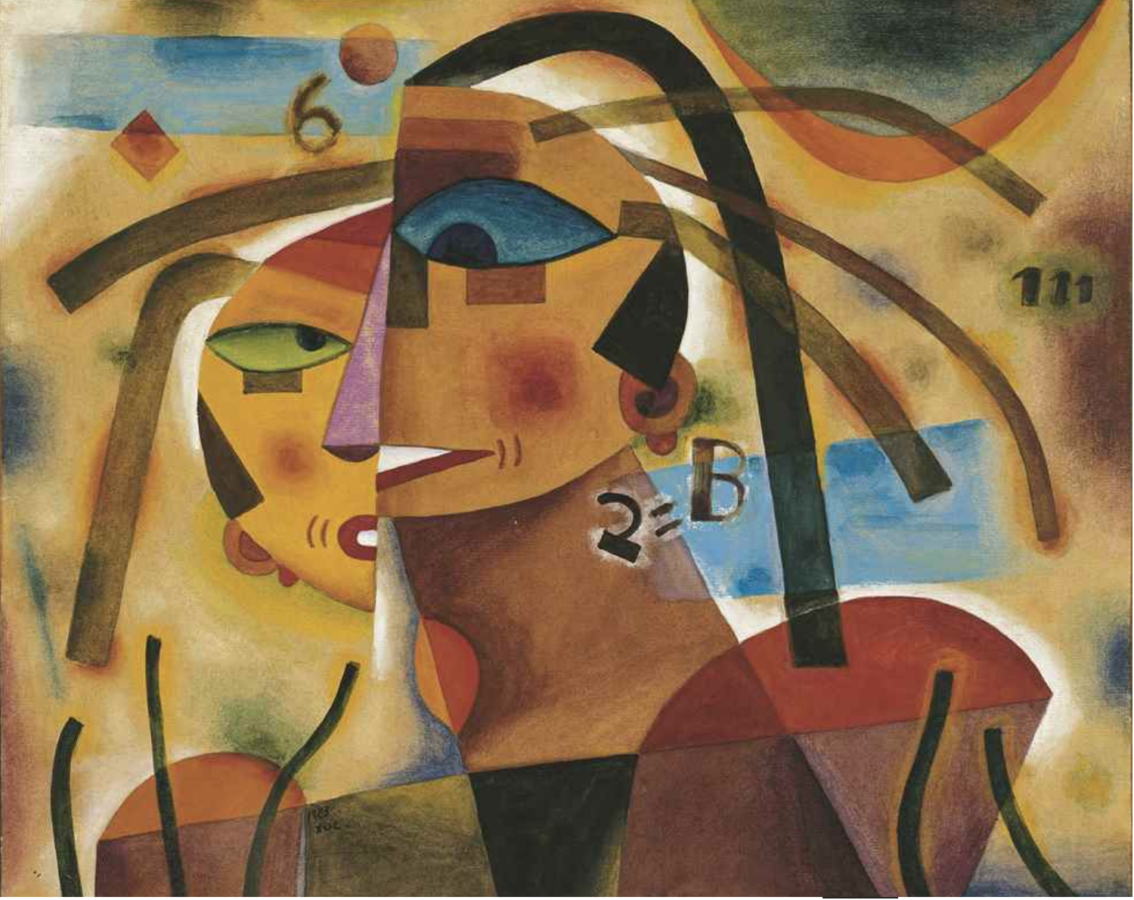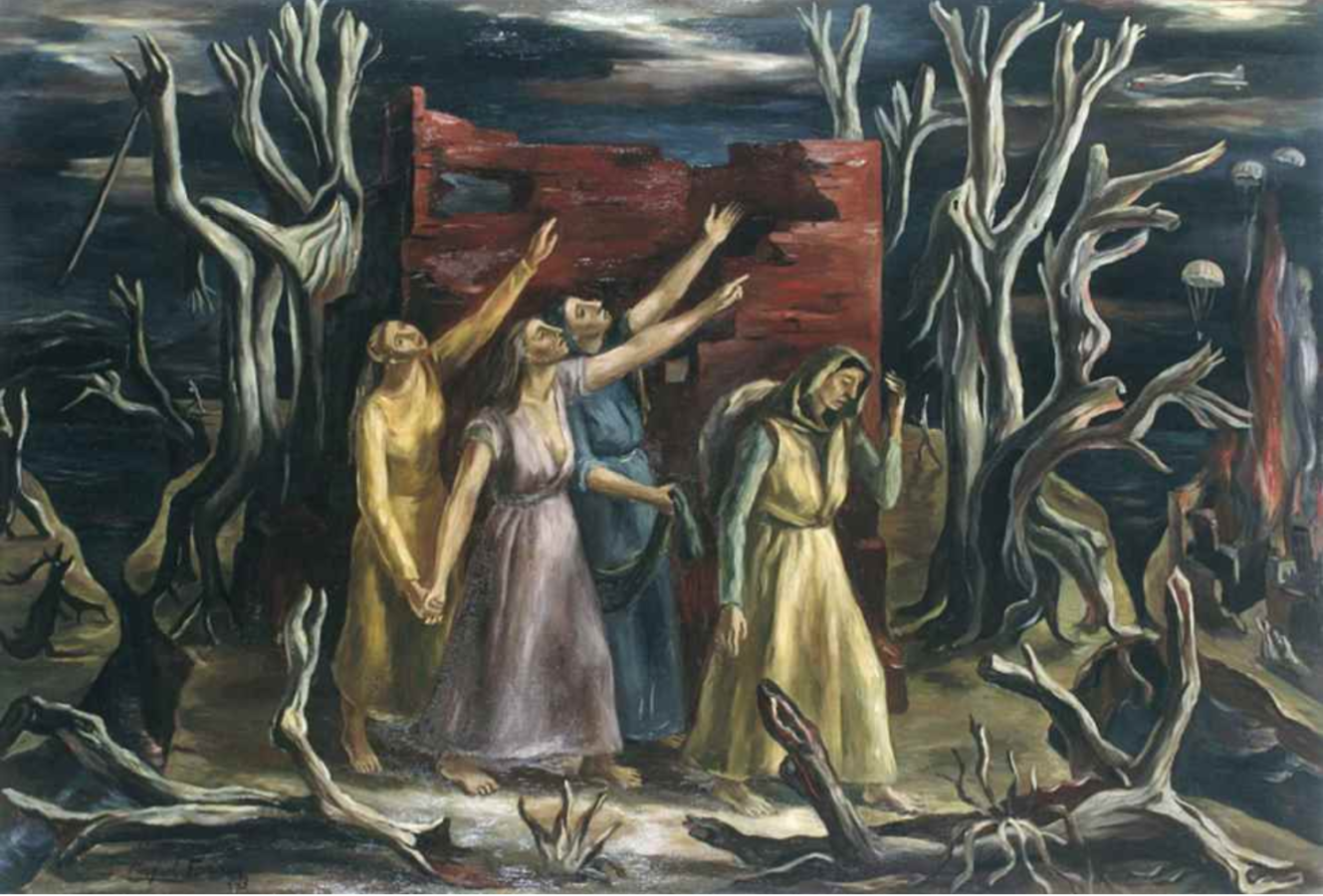Pernambuco Brasil Newspaper Street Art Y Art Deco Museo 2019
In that location is a truly amazing museum in Buenos Aires that is an accented must for art lovers! I visited MALBA during my travel in South America and got acquainted with masterpieces from that side of the earth.
The Museum of Latin American Art in Buenos Aires (MALBA) takes a special place amid the museums of the Argentine upper-case letter. It has an all-encompassing permanent collection of modern Latin American art betwixt 1900-1970. Moreover, the entry is a great value for Europeans! Visitors who are already familiar with South and Primal American art volition marvel at the allegorical names that this privately owned museum showcases, and for those who are just now getting to know these artists who are well-known on that continent, MALBA serves as a great introduction. Below is a pick of my favourite South American artworks from MALBA.
one. Cícero Dias (Brasil, 1907 – 2003): Playing children and the goodbye , 1930
[caption id="attachment_20261" marshal="aligncenter" width="984"] Cícero Dias, Playing children and the farewell (Crianças brincando e o adeus), 1930, MALBA, Buenos Aires[/caption] Dias created this picture at the beginning of his career. At this time he was in affect with the advanced move of Brazil. The composition is rather surrealistic and dream-like: linking a funeral scene to playing children; the deformed proportions of the figures compared to the plants; the lack of perspective. The artist uses ink with aquarelle, which besides gives a dreamy feeling to the image. At this menstruation of his career, Dias used more often than not this technique on his paintings. Sometimes he interpreted in his works the fantastic imaginative myths of the northwest of Brazil and his hometown, Pernambuco. From the second half of the 1920's, the northward of Brazil was an of import region for Brazilian modernism, with Recife its eye.
Cícero Dias, Playing children and the farewell (Crianças brincando e o adeus), 1930, MALBA, Buenos Aires[/caption] Dias created this picture at the beginning of his career. At this time he was in affect with the advanced move of Brazil. The composition is rather surrealistic and dream-like: linking a funeral scene to playing children; the deformed proportions of the figures compared to the plants; the lack of perspective. The artist uses ink with aquarelle, which besides gives a dreamy feeling to the image. At this menstruation of his career, Dias used more often than not this technique on his paintings. Sometimes he interpreted in his works the fantastic imaginative myths of the northwest of Brazil and his hometown, Pernambuco. From the second half of the 1920's, the northward of Brazil was an of import region for Brazilian modernism, with Recife its eye.
2. Joaquín Torres -García (Uruguay, 1874 – 1949): Constructive with street and large fish, 1946
[caption id="attachment_20265" marshal="aligncenter" width="1324"] Joaquín Torres-García, Effective with street and big fish (Constructivo con calle y gran pez), 1946, MALBA, Buenos Aires[/caption]
Joaquín Torres-García, Effective with street and big fish (Constructivo con calle y gran pez), 1946, MALBA, Buenos Aires[/caption]
1 of the nigh famous Uruguayan painters is well-known in South Americafor his montage-like style paintings and drawings, just like this one I present. Moreover, his oeuvre is very important even outside of Uruguay. He lived virtually of his life in Europe where he got involved with the early on avant-garde motion and established his own Constructivist style. Upon returning to his country, he instigated to a new generation of artists. This painting depicts objects and figures in compartments separated by straight lines, which is a geometric order similar to a grid-based urban landscape. The scenes are on the one hand typical of a city street: passers-by, driving car, people with suitcases, dogs. On the other paw there are symbols of South American indigenous culture, such as the fish, which is a returning element on many of his paintings. During his career, Torres-García produced a striking repertoire of synthetic brainchild (like this instance). Simplified forms and planes, fewer vantage points and text on the picture characterize this style.
Read nigh Montevideo, the cultural eye of Uruguay
iii. Antônio Dias (Brasil, 1944 – 2018): Beloved, are you alright?, 1964
[caption id="attachment_20262" align="aligncenter" width="668"] Antônio Dias, Dear, are you alright? (Querida, você está bem?), 1964, MALBA, Buenos Aires[/caption] The above abstract only figurative work caught my attention with its comic-like and diverse shapes, cacophony of figures, strong colours and mixed textures (acrylic on wood and hardboard). Most noteworthy, the shapes vary between straight lines and curvy, ghost- and penis-like images such as in the centre of the work. Dias created this epitome in the get-go of his career among other paintings with like, violent imagery. With his style he became a leading figure of theNova Figuração ('New Figuration') movement in Brazil. In that menstruation, he already started exploring paper equally an artistic cloth, which later became his trademark. History heavily influenced his life and fine art: due to the 1964 coup d'etat he went to self-imposed exile and his paintings reflected the Brazilian armed forces dictatorship. Hence the violent color scheme of the paintings from that flow, such asBeloved, are yous alright?. The title'due south "Dear" can exist interpreted as Brazil.
Antônio Dias, Dear, are you alright? (Querida, você está bem?), 1964, MALBA, Buenos Aires[/caption] The above abstract only figurative work caught my attention with its comic-like and diverse shapes, cacophony of figures, strong colours and mixed textures (acrylic on wood and hardboard). Most noteworthy, the shapes vary between straight lines and curvy, ghost- and penis-like images such as in the centre of the work. Dias created this epitome in the get-go of his career among other paintings with like, violent imagery. With his style he became a leading figure of theNova Figuração ('New Figuration') movement in Brazil. In that menstruation, he already started exploring paper equally an artistic cloth, which later became his trademark. History heavily influenced his life and fine art: due to the 1964 coup d'etat he went to self-imposed exile and his paintings reflected the Brazilian armed forces dictatorship. Hence the violent color scheme of the paintings from that flow, such asBeloved, are yous alright?. The title'due south "Dear" can exist interpreted as Brazil.
iv.Alejandro Xul Solar(Argentina, 1887 – 1963): Couple , 1923
[explanation id="attachment_20264" marshal="aligncenter" width="1134"] Alejandro Xul Solar, Couple (Pareja), 1923, MALBA, Buenos Aires[/caption] The paintings of Xul Solar stood out from the very first time I encountered them. Above all, their dream-like figures and bright colours create their ain imaginative language that talked to me in every piece.Couple is a portrait of 2 androgynous figures. The faces' overlap is a symbol of the closeness of the partners. Geometric forms are scattered on the colourful picture. Despite the fullness of the picture, the forms and colours harmonise and give a feeling of an alternative style cartoon. This painting in topic is quite different from his other pictures, which depict city landscapes, scenes with flying vehicles and figures in action.
Alejandro Xul Solar, Couple (Pareja), 1923, MALBA, Buenos Aires[/caption] The paintings of Xul Solar stood out from the very first time I encountered them. Above all, their dream-like figures and bright colours create their ain imaginative language that talked to me in every piece.Couple is a portrait of 2 androgynous figures. The faces' overlap is a symbol of the closeness of the partners. Geometric forms are scattered on the colourful picture. Despite the fullness of the picture, the forms and colours harmonise and give a feeling of an alternative style cartoon. This painting in topic is quite different from his other pictures, which depict city landscapes, scenes with flying vehicles and figures in action.
Many of Xul Solar's works tin be seen in the Xul Solar Museum in Buenos Aires. Read our urban center guide to Buenos Aires and find out why to visit it correct at present.
Autonomously from paintings, he also created objects: my favourite is a piano, where the keys, instead of being blackness and white, are colourful. Using this piano – where the colours correspond to music notes – his paintings tin be transformed to music. Linking musicality to painting connects him to Kandinsky, who likewise believed that shades resonate with each other to produce "visual chords".
5.Raquel Forner(Argentina, 1902 – 1988): Darkness , 1943
[caption id="attachment_20263" align="aligncenter" width="1329"] Raquel Forner, Darkness (Tinieblas), 1943, MALBA, Buenos Aires[/caption] Raquel Forner is ane of the rare female artists that I discovered in S American art museums. The topic of this pic is the devastation that the Globe War II was causing at that fourth dimension. Forner was interested in current events. Due to the devastating historical events of her fourth dimension, many works of hers air a dark atmosphere. Forner's paintings often stand for female characters, like this i showing women in despair. Later, she turned her attention to space and interplanetary travel. She was one of the first artists to paint the outer space in herSpace andMoon Series. Bank check out her other pictures (including some of her space topic paintings) on the website of the Forner-Bigatti Foundation. (Also, read an interesting article about howspace race altered art in the Americas.) Read here MALBA's informative introduction to its collection (in Spanish). Address:Museo de Arte Latinoamericano de Buenos Aires - Av. Figueroa Alcorta 3415, C1425CLA Buenos Aires, Argentina
Raquel Forner, Darkness (Tinieblas), 1943, MALBA, Buenos Aires[/caption] Raquel Forner is ane of the rare female artists that I discovered in S American art museums. The topic of this pic is the devastation that the Globe War II was causing at that fourth dimension. Forner was interested in current events. Due to the devastating historical events of her fourth dimension, many works of hers air a dark atmosphere. Forner's paintings often stand for female characters, like this i showing women in despair. Later, she turned her attention to space and interplanetary travel. She was one of the first artists to paint the outer space in herSpace andMoon Series. Bank check out her other pictures (including some of her space topic paintings) on the website of the Forner-Bigatti Foundation. (Also, read an interesting article about howspace race altered art in the Americas.) Read here MALBA's informative introduction to its collection (in Spanish). Address:Museo de Arte Latinoamericano de Buenos Aires - Av. Figueroa Alcorta 3415, C1425CLA Buenos Aires, Argentina
Entry: 170 ARS, on Wednesdays 85 ARS
Source: https://www.dailyartmagazine.com/south-american-artists-malba/
Post a Comment for "Pernambuco Brasil Newspaper Street Art Y Art Deco Museo 2019"